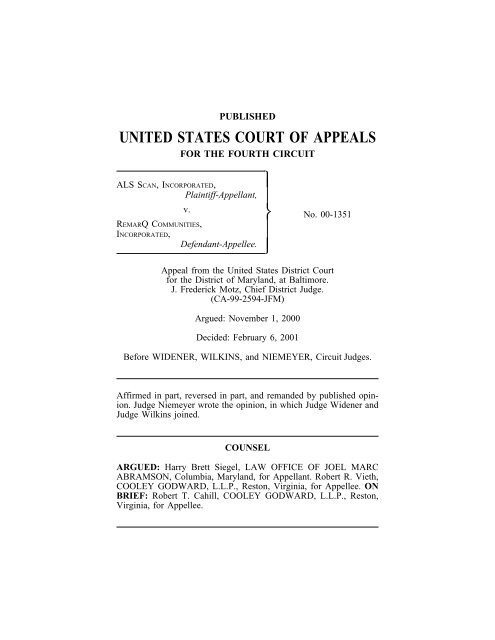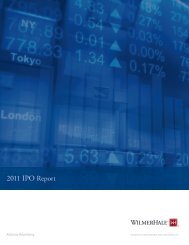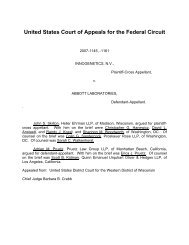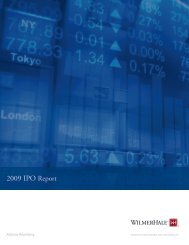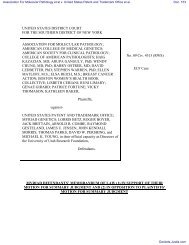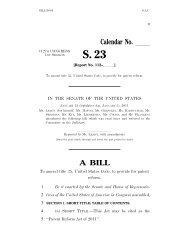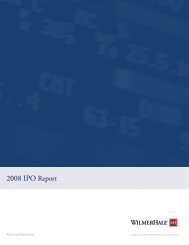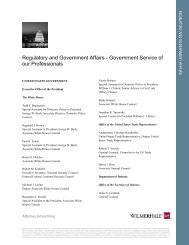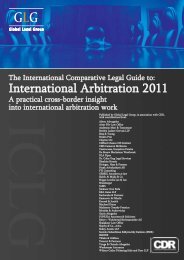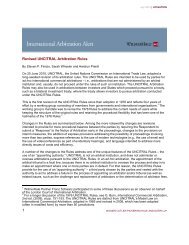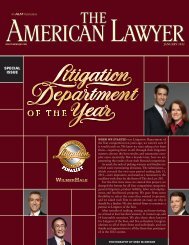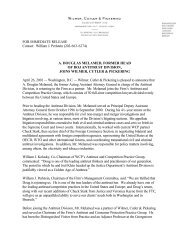ALS SCAN, INC. v. REMARQ COMMUNITIES, INC. - Court of ...
ALS SCAN, INC. v. REMARQ COMMUNITIES, INC. - Court of ...
ALS SCAN, INC. v. REMARQ COMMUNITIES, INC. - Court of ...
Create successful ePaper yourself
Turn your PDF publications into a flip-book with our unique Google optimized e-Paper software.
PUBLISHEDUNITED STATES COURT OF APPE<strong>ALS</strong>FOR THE FOURTH CIRCUIT<strong>ALS</strong> <strong>SCAN</strong>, <strong>INC</strong>ORPORATED,Plaintiff-Appellant,v.⎫⎬<strong>REMARQ</strong> <strong>COMMUNITIES</strong>,<strong>INC</strong>ORPORATED,Defendant-Appellee.⎭No. 00-1351Appeal from the United States District <strong>Court</strong>for the District <strong>of</strong> Maryland, at Baltimore.J. Frederick Motz, Chief District Judge.(CA-99-2594-JFM)Argued: November 1, 2000Decided: February 6, 2001Before WIDENER, WILKINS, and NIEMEYER, Circuit Judges.Affirmed in part, reversed in part, and remanded by published opinion.Judge Niemeyer wrote the opinion, in which Judge Widener andJudge Wilkins joined.COUNSELARGUED: Harry Brett Siegel, LAW OFFICE OF JOEL MARCABRAMSON, Columbia, Maryland, for Appellant. Robert R. Vieth,COOLEY GODWARD, L.L.P., Reston, Virginia, for Appellee. ONBRIEF: Robert T. Cahill, COOLEY GODWARD, L.L.P., Reston,Virginia, for Appellee.
2 <strong>ALS</strong> <strong>SCAN</strong>, <strong>INC</strong>. v. <strong>REMARQ</strong> <strong>COMMUNITIES</strong>, <strong>INC</strong>.NIEMEYER, Circuit Judge:OPINIONWe are presented with an issue <strong>of</strong> first impression — whether anInternet service provider enjoys a safe harbor from copyright infringementliability as provided by Title II <strong>of</strong> the Digital Millennium CopyrightAct ("DMCA") when it is put on notice <strong>of</strong> infringement activityon its system by an imperfect notice. Because we conclude that theservice provider was provided with a notice <strong>of</strong> infringing activity thatsubstantially complied with the Act, it may not rely on a claim <strong>of</strong>defective notice to maintain the immunity defense provided by thesafe harbor. Accordingly, we reverse the ruling <strong>of</strong> the district courtthat found the notice fatally defective, and affirm its remaining rulings.I<strong>ALS</strong> Scan, Inc., a Maryland corporation, is engaged in the business<strong>of</strong> creating and marketing "adult" photographs. It displays these pictureson the Internet to paying subscribers and also sells them throughthe media <strong>of</strong> CD ROMs and videotapes. <strong>ALS</strong> Scan is holder <strong>of</strong> thecopyrights for all <strong>of</strong> these photographs.RemarQ Communities, Inc., a Delaware corporation, is an onlineInternet service provider that provides access to its subscribing members.It has approximately 24,000 subscribers to its newsgroup baseand provides access to over 30,000 newsgroups which cover thousands<strong>of</strong> subjects. These newsgroups, organized by topic, enable subscribersto participate in discussions on virtually any topic, such asfine arts, politics, religion, social issues, sports, and entertainment.For example, RemarQ provides access to a newsgroup entitled "BaltimoreOrioles," in which users share observations or materials aboutthe Orioles. It claims that users post over one million articles a dayin these newsgroups, which RemarQ removes after about 8-10 daysto accommodate its limited server capacity. In providing access tonewsgroups, RemarQ does not monitor, regulate, or censor the content<strong>of</strong> articles posted in the newsgroup by subscribing members. Itdoes, however, have the ability to filter information contained in the
<strong>ALS</strong> <strong>SCAN</strong>, <strong>INC</strong>. v. <strong>REMARQ</strong> <strong>COMMUNITIES</strong>, <strong>INC</strong>.newsgroups and to screen its members from logging onto certainnewsgroups, such as those containing pornographic material.Two <strong>of</strong> the newsgroups to which RemarQ provides its subscribersaccess contain <strong>ALS</strong> Scan’s name in the titles. These newsgroups —"alt.als" and "alt.binaries.pictures.erotica.als" — contain hundreds <strong>of</strong>postings that infringe <strong>ALS</strong> Scan’s copyrights. These postings areplaced in these newsgroups by RemarQ’s subscribers.Upon discovering that RemarQ databases contained material thatinfringed <strong>ALS</strong> Scan’s copyrights, <strong>ALS</strong> Scan sent a letter, datedAugust 2, 1999, to RemarQ, stating:Both <strong>of</strong> these newsgroups ["alt.als" and"alt.binaries.pictures.erotica.als"] were created for the solepurpose <strong>of</strong> violating our Federally filed Copyrights andTradename. These newsgroups contain virtually all FederallyCopyrighted images. . . . Your servers provide accessto these illegally posted images and enable the illegal transmission<strong>of</strong> these images across state lines.This is a cease and desist letter. You are hereby orderedto cease carrying these newsgroups within twenty-four (24)hours upon receipt <strong>of</strong> this correspondence . . . .America Online, Erol’s, Mindspring, and others have allcomplied with our cease and desist order and no longercarry these newsgroups.* * *Our <strong>ALS</strong> Scan models can be identified athttp://www.alsscan.com/modlinf2.html[.] Our copyrightinformation can be reviewed at http://www.alsscan.com/copyrite.html[.]RemarQ responded by refusing to comply with <strong>ALS</strong> Scan’s demandbut advising <strong>ALS</strong> Scan that RemarQ would eliminate individualinfringing items from these newsgroups if <strong>ALS</strong> Scan identified them3
4 <strong>ALS</strong> <strong>SCAN</strong>, <strong>INC</strong>. v. <strong>REMARQ</strong> <strong>COMMUNITIES</strong>, <strong>INC</strong>."with sufficient specificity." <strong>ALS</strong> Scan answered that RemarQ hadincluded over 10,000 copyrighted images belonging to <strong>ALS</strong> Scan inits newsgroups over the period <strong>of</strong> several months and that[t]hese newsgroups have apparently been created by individualsfor the express sole purpose <strong>of</strong> illegally posting, transferringand disseminating photographs that have beencopyrighted by my client through both its websites and itsCD-ROMs. The newsgroups, on their face from reviewingmessages posted thereon, serve no other purpose.When correspondence between the parties progressed no further toresolution <strong>of</strong> the dispute, <strong>ALS</strong> Scan commenced this action, allegingviolations <strong>of</strong> the Copyright Act and Title II <strong>of</strong> the DMCA, as well asunfair competition. In its complaint, <strong>ALS</strong> Scan alleged that RemarQpossessed actual knowledge that the newsgroups contained infringingmaterial but had "steadfastly refused to remove or block access to thematerial." <strong>ALS</strong> Scan also alleged that RemarQ was put on notice by<strong>ALS</strong> Scan <strong>of</strong> the infringing material contained in its database. In additionto injunctive relief, <strong>ALS</strong> Scan demanded actual and statutorydamages, as well as attorneys fees. It attached to its complaint affidavitsestablishing the essential elements <strong>of</strong> its claims.In response, RemarQ filed a motion to dismiss the complaint or, inthe alternative, for summary judgment, and also attached affidavits,stating that RemarQ was prepared to remove articles posted in itsnewsgroups if the allegedly infringing articles were specifically identified.It contended that because it is a provider <strong>of</strong> access to newsgroups,<strong>ALS</strong> Scan’s failure to comply with the DMCA notice requirementsprovided it with a defense to <strong>ALS</strong> Scan’s copyright infringementclaim.The district court ruled on RemarQ’s motion, stating, "[RemarQ’s]motion to dismiss or for summary judgment is treated as one to dismissand, as such, is granted." In making this ruling, the district courtheld: (1) that RemarQ could not be held liable for direct copyrightinfringement merely because it provided access to a newsgroup containinginfringing material; and (2) that RemarQ could not be held liablefor contributory infringement because <strong>ALS</strong> Scan failed to comply
<strong>ALS</strong> <strong>SCAN</strong>, <strong>INC</strong>. v. <strong>REMARQ</strong> <strong>COMMUNITIES</strong>, <strong>INC</strong>.with the notice requirements set forth in the DMCA, 17 U.S.C.§ 512(c)(3)(A). This appeal followed.II<strong>ALS</strong> Scan contends first that the district court erred in dismissingits direct copyright infringement claim. It contends that it stated acause <strong>of</strong> action for copyright infringement when it alleged (1) the"ownership <strong>of</strong> valid copyrights," and (2) RemarQ’s violation <strong>of</strong> itscopyrights "by allowing its members access to newsgroups containinginfringing material." 1 See generally Keeler Brass Co. v. ContinentalBrass Co., 862 F.2d 1063, 1065 (4th Cir. 1988) (describing therequirements <strong>of</strong> a direct infringement claim). In rejecting <strong>ALS</strong> Scan’sdirect infringement claim, the district court relied on the decision inReligious Technology Center v. Netcom On-Line Communication Services,Inc., 907 F. Supp. 1361, 1368-73 (N.D. Cal. 1995), which concludedthat when an Internet provider serves, without humanintervention, as a passive conduit for copyrighted material, it is notliable as a direct infringer. The Netcom court reasoned that "it doesnot make sense to adopt a rule that could lead to liability <strong>of</strong> countlessparties whose role in the infringement is nothing more than setting upand operating a system that is necessary for the functioning <strong>of</strong> theInternet." Id. at 1372. That court observed that it would not be workableto hold "the entire Internet liable for activities that cannot reasonablybe deterred." Id.; see also Marobie-FL, Inc. v. National Ass’n <strong>of</strong>Fire Equip. Distribs., 983 F. Supp. 1167, 1176-79 (N.D. Ill. 1997)(agreeing with Netcom’s reasoning). <strong>ALS</strong> Scan argues, however, thatthe better reasoned position, contrary to that held in Netcom, is presentedin Playboy Enterprises, Inc. v. Frena, 839 F. Supp. 1552, 1555-59 (M.D. Fla. 1993), which held a computer bulletin board serviceprovider liable for the copyright infringement when it failed to preventthe placement <strong>of</strong> plaintiff’s copyrighted photographs in its sys-1It would appear that <strong>ALS</strong> Scan’s allegations amount more to a claim<strong>of</strong> contributory infringement in which a defendant, "with knowledge <strong>of</strong>the infringing activity, induces, causes or materially contributes to theinfringing conduct <strong>of</strong> another," Gershwin Publ’g Corp. v. Columbia ArtistsMgmt., Inc., 443 F.2d 1159, 1162 (2d Cir. 1971), than to a claim <strong>of</strong>direct infringement.5
6 <strong>ALS</strong> <strong>SCAN</strong>, <strong>INC</strong>. v. <strong>REMARQ</strong> <strong>COMMUNITIES</strong>, <strong>INC</strong>.tem, despite any pro<strong>of</strong> that the provider had any knowledge <strong>of</strong> theinfringing activities.Although we find the Netcom court reasoning more persuasive, theultimate conclusion on this point is controlled by Congress’ codification<strong>of</strong> the Netcom principles in Title II <strong>of</strong> the DMCA. As the HouseReport for that Act states,The bill distinguishes between direct infringement andsecondary liability, treating each separately. This structureis consistent with evolving case law, and appropriate in light<strong>of</strong> the different legal bases for and policies behind the differentforms <strong>of</strong> liability.As to direct infringement, liability is ruled out for passive,automatic acts engaged in through a technological processinitiated by another. Thus the bill essentially codifies theresult in the leading and most thoughtful judicial decision todate: Religious Technology Center v. Netcom On-Line CommunicationsServices, Inc., 907 F. Supp. 1361 (N.D. Cal.1995). In doing so, it overrules these aspects <strong>of</strong> PlayboyEnterprises, Inc. v. Frena, 839 F. Supp. 1552 (M.D. Fla.1993), ins<strong>of</strong>ar as that case suggests that such acts by serviceproviders could constitute direct infringement, and providescertainty that Netcom and its progeny, so far only a few districtcourt cases, will be the law <strong>of</strong> the land.H.R. Rep. No. 105-551(I), at 11 (1998). Accordingly, we address only<strong>ALS</strong> Scan’s claims brought under the DMCA itself.IIIFor its principal argument, <strong>ALS</strong> Scan contends that it substantiallycomplied with the notification requirements <strong>of</strong> the DMCA andthereby denied RemarQ the "safe harbor" from copyright infringementliability granted by that Act. See 17 U.S.C. § 512(c)(3)(A) (settingforth notification requirements). It asserts that because itsnotification was sufficient to put RemarQ on notice <strong>of</strong> its infringementactivities, RemarQ lost its service-provider immunity from
<strong>ALS</strong> <strong>SCAN</strong>, <strong>INC</strong>. v. <strong>REMARQ</strong> <strong>COMMUNITIES</strong>, <strong>INC</strong>.infringement liability. It argues that the district court’s application <strong>of</strong>the DMCA was overly strict and that Congress did not intend to permitInternet providers to avoid copyright infringement liability"merely because a cease and desist notice failed to technically complywith the DMCA."RemarQ argues in response that it did not have "knowledge <strong>of</strong> theinfringing activity as a matter <strong>of</strong> law," stating that the DMCA protectsit from liability because "<strong>ALS</strong> Scan failed to identify the infringingworks in compliance with the Act, and RemarQ falls within the ‘safeharbor’ provisions <strong>of</strong> the Act." It notes that <strong>ALS</strong> Scan never providedRemarQ or the district court with the identity <strong>of</strong> the pictures formingthe basis <strong>of</strong> its copyright infringement claim.These contentions <strong>of</strong> the parties present the issue <strong>of</strong> whether <strong>ALS</strong>Scan complied with the notification requirements <strong>of</strong> the DMCA so asto deny RemarQ the safe-harbor defense to copyright infringementliability afforded by that Act.Title II <strong>of</strong> the DMCA, designated the "Online Copyright InfringementLimitation Act," DMCA, § 201, Pub. L. 105-304, 112 Stat. 2877(1998) (codified at 17 U.S.C. § 101 note), defines limitations <strong>of</strong> liabilityfor copyright infringement to which Internet service providersmight otherwise be exposed. The Act defines a service providerbroadly to include any provider <strong>of</strong> "online services or network access,or the operator <strong>of</strong> facilities therefor," including any entity providing"digital online communications, between or among points specifiedby user, <strong>of</strong> material <strong>of</strong> the user’s choosing, without modification tothe content <strong>of</strong> the material as sent or received." 17 U.S.C. § 512(k).Neither party to this case suggests that RemarQ is not an Internet serviceprovider for purposes <strong>of</strong> the Act.The liability-limiting provision applicable here, 17 U.S.C. § 512(c),gives Internet service providers a safe harbor from liability for "infringement<strong>of</strong> copyright by reason <strong>of</strong> the storage at the direction <strong>of</strong>a user <strong>of</strong> material that resides on a system or network controlled oroperated by or for the service provider" as long as the service providercan show that: (1) it has neither actual knowledge that its systemcontains infringing materials nor an awareness <strong>of</strong> facts or circumstancesfrom which infringement is apparent, or it has expeditiously7
8 <strong>ALS</strong> <strong>SCAN</strong>, <strong>INC</strong>. v. <strong>REMARQ</strong> <strong>COMMUNITIES</strong>, <strong>INC</strong>.removed or disabled access to infringing material upon obtainingactual knowledge <strong>of</strong> infringement; (2) it receives no financial benefitdirectly attributable to infringing activity; and (3) it responded expeditiouslyto remove or disable access to material claimed to beinfringing after receiving from the copyright holder a notificationconforming with requirements <strong>of</strong> § 512(c)(3). Id. § 512(c)(1). 2 Thus,to qualify for this safe harbor protection, the Internet service providermust demonstrate that it has met all three <strong>of</strong> the safe harbor requirements,and a showing under the first prong — the lack <strong>of</strong> actual orconstructive knowledge — is prior to and separate from the showingsthat must be made under the second and third prongs.2Section 512(c)(1) provides in full:(c)Information residing on systems or networks at direction <strong>of</strong>users.—(1) In general.—A service provider shall not be liable for monetaryrelief, or, except as provided in subsection (j), forinjunctive or other equitable relief, for infringement <strong>of</strong>copyright by reason <strong>of</strong> the storage at the direction <strong>of</strong> a user<strong>of</strong> material that resides on a system or network controlledor operated by or for the service provider, if the serviceprovider—(A)(i) does not have actual knowledge that the materialor an activity using the material on the system or networkis infringing;(ii) in the absence <strong>of</strong> such actual knowledge, is not aware<strong>of</strong> facts or circumstances from which infringing activity isapparent; or(iii) upon obtaining such knowledge or awareness, actsexpeditiously to remove, or disable access to, the material;(B) does not receive a financial benefit directly attributableto the infringing activity, in a case in which the serviceprovider has the right and ability to control such activity;and(C) upon notification <strong>of</strong> claimed infringement asdescribed in paragraph (3), responds expeditiously toremove, or disable access to, the material that is claimed tobe infringing or to be the subject <strong>of</strong> infringing activity.
<strong>ALS</strong> <strong>SCAN</strong>, <strong>INC</strong>. v. <strong>REMARQ</strong> <strong>COMMUNITIES</strong>, <strong>INC</strong>.In this case, the district court evaluated the adequacy given toRemarQ under the third prong only. Despite the fact the district courtstated it was treating RemarQ’s motion as a motion to dismiss, ratherthan as a motion for summary judgment, the court’s memorandumopinion fails to mention the allegation made in <strong>ALS</strong> Scan’s complaintthat RemarQ had actual knowledge <strong>of</strong> the infringing nature <strong>of</strong> the twosubject newsgroups even before being contacted by <strong>ALS</strong> Scan, anallegation denied by RemarQ. Clearly, had the court truly been evaluating<strong>ALS</strong> Scan’s complaint under a 12(b)(6) standard <strong>of</strong> review, itwould necessarily have had to accept <strong>ALS</strong> Scan’s allegation asproven for purposes <strong>of</strong> testing the adequacy <strong>of</strong> the complaint, seeEastern Shore Markets, Inc. v. J.D. Assoc. Ltd. P’ship, 213 F.3d 175,180 (4th Cir. 2000), and consequently been required to rule in favor<strong>of</strong> <strong>ALS</strong> Scan under the first prong.Even if we were to treat the district court’s order as disposing <strong>of</strong>a motion for summary judgment, and not a motion to dismiss, thecourt still could not, as a matter <strong>of</strong> law, have resolved the conflictingaffidavits about actual knowledge. Resolving whether the court actuallytreated the motion as one to dismiss or for summary judgment isnot necessary, however, because we conclude that <strong>ALS</strong> Scan substantiallycomplied with the third prong, thereby denying RemarQ its safeharbor defense.In evaluating the third prong, requiring RemarQ to remove materialsfollowing "notification," the district court concluded that <strong>ALS</strong>Scan’s notice was defective in failing to comply strictly with two <strong>of</strong>the six requirements <strong>of</strong> a notification — (1) that <strong>ALS</strong> Scan’s noticeinclude "a list <strong>of</strong> [infringing] works" contained on the RemarQ siteand (2) that the notice identify the infringing works in sufficient detailto enable RemarQ to locate and disable them. 17 U.S.C.§ 512(c)(3)(A)(ii), (iii). 33Section 512(c)(3)(A)(ii), (iii) provides:(3) Elements <strong>of</strong> notification.—(A) To be effective under this subsection, a notification <strong>of</strong>claimed infringement must be a written communication providedto the designated agent <strong>of</strong> a service provider that includes substantiallythe following:9
10 <strong>ALS</strong> <strong>SCAN</strong>, <strong>INC</strong>. v. <strong>REMARQ</strong> <strong>COMMUNITIES</strong>, <strong>INC</strong>.In support <strong>of</strong> the district court’s conclusion, RemarQ points to thefact that <strong>ALS</strong> Scan never provided it with a "representative list" <strong>of</strong> theinfringing photographs, as required by § 512(c)(3)(A)(ii), nor did itidentify those photographs with sufficient detail to enable RemarQ tolocate and disable them, as required by § 512(c)(3)(A)(iii). RemarQbuttresses its contention with the observation that not all materials atthe <strong>of</strong>fending sites contained material to which <strong>ALS</strong> Scan held thecopyrights. RemarQ’s affidavit states in this regard:Some, but not all, <strong>of</strong> the pictures users have posted on thesesites appear to be <strong>ALS</strong> Scan pictures. It also appears thatusers have posted other non-<strong>ALS</strong> Scan’s erotic images onthese newsgroups. The articles in these newsgroups alsocontain text messages, many <strong>of</strong> which discuss the adultimages posted on the newsgroups.<strong>ALS</strong> Scan responds that the two sites in question — "alt.als" and"alt.binaries.pictures.erotica.als" — were created solely for the purpose<strong>of</strong> publishing and exchanging <strong>ALS</strong> Scan’s copyrighted images.It points out that the address <strong>of</strong> the newsgroup is defined by <strong>ALS</strong>Scan’s name. As one <strong>of</strong> its affidavits states:[RemarQ’s] subscribers going onto the two <strong>of</strong>fending newsgroupsfor the purpose <strong>of</strong> violating [<strong>ALS</strong> Scan’s] copyrights,are actually aware <strong>of</strong> the copyrighted status <strong>of</strong> [<strong>ALS</strong>Scan’s] material because (1) each newsgroup has "als" aspart <strong>of</strong> its title, and (2) each photograph belonging to [<strong>ALS</strong>* * *(ii) Identification <strong>of</strong> the copyrighted work claimed to havebeen infringed, or, if multiple copyrighted works at a singleonline site are covered by a single notification, a representativelist <strong>of</strong> such works at that site.(iii) Identification <strong>of</strong> the material that is claimed to beinfringing or to be the subject <strong>of</strong> infringing activity and thatis to be removed or access to which is to be disabled, andinformation reasonably sufficient to permit the service providerto locate the material.
<strong>ALS</strong> <strong>SCAN</strong>, <strong>INC</strong>. v. <strong>REMARQ</strong> <strong>COMMUNITIES</strong>, <strong>INC</strong>.Scan] has [<strong>ALS</strong> Scan’s] name and/or the copyright symbolnext to it.11Each <strong>of</strong> these two newsgroups was created by unknownpersons for the illegal purpose <strong>of</strong> trading the copyrightedpictures <strong>of</strong> [<strong>ALS</strong> Scan] to one another without the need forpaying to either (1) become members <strong>of</strong> [<strong>ALS</strong> Scan’s] website(s) or (2) purchasing the CD-ROMs produced by [<strong>ALS</strong>Scan].<strong>ALS</strong> Scan presses the contention that these two sites serve no otherpurpose than to distribute <strong>ALS</strong> Scan’s copyrighted materials andtherefore, by directing RemarQ to these sites, it has directed RemarQto a representative list <strong>of</strong> infringing materials.The DMCA was enacted both to preserve copyright enforcementon the Internet and to provide immunity to service providers fromcopyright infringement liability for "passive," "automatic" actions inwhich a service provider’s system engages through a technologicalprocess initiated by another without the knowledge <strong>of</strong> the service provider.H.R. Conf. Rep. No. 105-796, at 72 (1998), reprinted in 1998U.S.C.C.A.N. 649; H.R. Rep. No. 105-551(I), at 11 (1998). Thisimmunity, however, is not presumptive, but granted only to "innocent"service providers who can prove they do not have actual or constructiveknowledge <strong>of</strong> the infringement, as defined under any <strong>of</strong> thethree prongs <strong>of</strong> 17 U.S.C. § 512(c)(1). The DMCA’s protection <strong>of</strong> aninnocent service provider disappears at the moment the service providerloses its innocence, i.e., at the moment it becomes aware thata third party is using its system to infringe. At that point, the Actshifts responsibility to the service provider to disable the infringingmatter, "preserv[ing] the strong incentives for service providers andcopyright owners to cooperate to detect and deal with copyrightinfringements that take place in the digital networked environment."H.R. Conf. Rep. No. 105-796, at 72 (1998), reprinted in 1998U.S.C.C.A.N. 649. In the spirit <strong>of</strong> achieving a balance between theresponsibilities <strong>of</strong> the service provider and the copyright owner, theDMCA requires that a copyright owner put the service provider onnotice in a detailed manner but allows notice by means that comportwith the prescribed format only "substantially," rather than perfectly.The Act states: "To be effective under this subsection, a notification
12 <strong>ALS</strong> <strong>SCAN</strong>, <strong>INC</strong>. v. <strong>REMARQ</strong> <strong>COMMUNITIES</strong>, <strong>INC</strong>.<strong>of</strong> claimed infringement must be a written communication providedto the designated agent <strong>of</strong> a service provider that includes substantiallythe following . . . ." 17 U.S.C. § 512(c)(3)(A) (emphasis added).In addition to substantial compliance, the notification requirementsare relaxed to the extent that, with respect to multiple works, not allmust be identified — only a "representative" list. See id.§ 512(c)(3)(A)(ii). And with respect to location information, thecopyright holder must provide information that is "reasonably sufficient"to permit the service provider to "locate" this material. Id.§ 512(c)(3)(A)(iii) (emphasis added). This subsection specifying therequirements <strong>of</strong> a notification does not seek to burden copyright holderswith the responsibility <strong>of</strong> identifying every infringing work — oreven most <strong>of</strong> them — when multiple copyrights are involved. Instead,the requirements are written so as to reduce the burden <strong>of</strong> holders <strong>of</strong>multiple copyrights who face extensive infringement <strong>of</strong> their works.Thus, when a letter provides notice equivalent to a list <strong>of</strong> representativeworks that can be easily identified by the service provider, thenotice substantially complies with the notification requirements.In this case, <strong>ALS</strong> Scan provided RemarQ with information that (1)identified two sites created for the sole purpose <strong>of</strong> publishing <strong>ALS</strong>Scan’s copyrighted works, (2) asserted that virtually all the images atthe two sites were its copyrighted material, and (3) referred RemarQto two web addresses where RemarQ could find pictures <strong>of</strong> <strong>ALS</strong>Scan’s models and obtain <strong>ALS</strong> Scan’s copyright information. In addition,it noted that material at the site could be identified as <strong>ALS</strong>Scan’s material because the material included <strong>ALS</strong> Scan’s "nameand/or copyright symbol next to it." We believe that with this information,<strong>ALS</strong> Scan substantially complied with the notificationrequirement <strong>of</strong> providing a representative list <strong>of</strong> infringing material aswell as information reasonably sufficient to enable RemarQ to locatethe infringing material. To the extent that <strong>ALS</strong> Scan’s claims aboutinfringing materials prove to be false, RemarQ has remedies for anyinjury it suffers as a result <strong>of</strong> removing or disabling noninfringingmaterial. See 17 U.S.C. § 512(f), (g).Accordingly, we reverse the district court’s ruling granting summaryjudgment in favor <strong>of</strong> RemarQ on the basis <strong>of</strong> <strong>ALS</strong> Scan’s noncompliancewith the notification provisions <strong>of</strong> 17 U.S.C.§ 512(c)(3)(A)(ii) and (iii). Because our ruling only removes the safe
<strong>ALS</strong> <strong>SCAN</strong>, <strong>INC</strong>. v. <strong>REMARQ</strong> <strong>COMMUNITIES</strong>, <strong>INC</strong>.harbor defense, we remand for further proceedings on <strong>ALS</strong> Scan’scopyright infringement claims and any other affirmative defenses thatRemarQ may have.IV<strong>ALS</strong> Scan also appeals the district court’s decision not to entersummary judgment on its behalf with respect to its infringementclaim. Because there is a dispute as to several material facts, however,we affirm the district court’s ruling on <strong>ALS</strong> Scan’s motion for summaryjudgment. If <strong>ALS</strong> Scan is able to prove that in fact the <strong>of</strong>fendingnewsgroups’ "sole purpose" is infringement <strong>of</strong> <strong>ALS</strong> Scan’s copyrights,it may be entitled to a remedy. However, because it is contestedboth that such is, in fact, the "sole" purpose <strong>of</strong> the newsgroups,and that "virtually all" the images posted in the newsgroups areinfringing, we are unable to come to any legal conclusions. Final dispositionmust await further development <strong>of</strong> the record and further proceedings.VAccordingly, for the reasons given, we reverse the district court’sdecision to grant summary judgment in favor <strong>of</strong> RemarQ, affirm thedistrict court’s decision not to grant summary judgment in favor <strong>of</strong><strong>ALS</strong> Scan, and remand this case for further proceedings consistentwith this opinion.13AFFIRMED IN PART, REVERSEDIN PART, AND REMANDED


